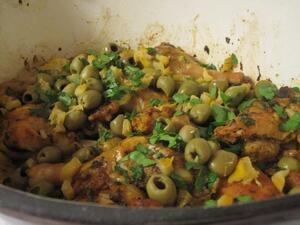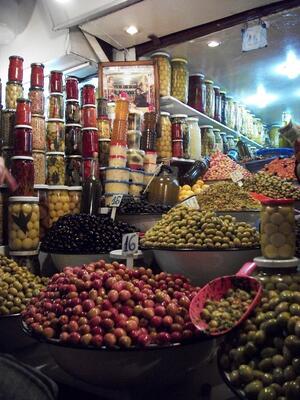Eating Jewish: Moroccan chicken with olives and lemons
My inspiration for the dishes I write about on Eating Jewish come from a variety of places that range from the numerous cookbooks that I have around my apartment, articles concerning Jewish food in newspapers and magazines, or simply the ingredients that I happen to have on hand at the moment. However, for this dish my inspiration came from my own academic work concerning the Moroccan Jewish community of Montreal. My research focuses on the food of Passover within this community in order to understand the ways in which these foods and the practices surrounding them influence the identity of Moroccan Jews in Montreal. Through a series of interviews, I will examine the ways in which these practices have both changed and remained the same after having been transplanted to this new environment. Although, I won’t solely be interviewing women within the community, they will remain a strong focus in my research due to their central role surrounding food preparation.
In recent months I began performing these interviews with members of the Moroccan Jewish community in Montreal during which I was told about many delicious recipes. In one case I was invited to Shabbat dinner at the home of a woman I interviewed and for one of the courses I was served a dish of chicken cooked with olives and preserved lemons. I had previously seen recipes for this dish and been told about it by various people but I had never had the opportunity to taste it. Although, after trying it at dinner that night I knew that I had to try my hand at making it.
This is a popular Moroccan dish that the Jewish community adopted from the cuisine of the larger non-Jewish community, but in doing so adapted it to conform to the laws of kashrut by cooking this dish using oil rather than the traditional ingredient of smen, which is clarified butter that is mixed with salt and stored in stoneware or earthenware pots. This dish became such an integral part of the Moroccan Jewish culinary repertoire that members of the community continued to prepare it in the countries to which the majority of the community immigrated, such as Israel, France and Canada (in particular Montreal).
On my visit to Morocco last year while walking through the Djemaa el Fna in Marrakesh, I came across vendors whose stalls were piled high with mountains of olives of various varieties alongside jars of preserved lemons. It was a beautiful sight to see (especially for an olive lover like myself) and has to be one of my favorite food related memories of the trip. This dish, in which the olives and the preserved lemons provide a wonderful combination of salty and tart flavors, seems to be the perfect explanation as to why these two ingredients were being sold side by side in Marrakesh.
Although it is often served at Shabbat dinner, according to Joan Nathan this dish is also served to break the fast of Yom Kippur by Moroccan Jews living in Israel. The traditional method of cooking it would be to do so in a clay tagine, a deep dish topped with a cone-shaped lid in which meals are both prepared and served. However, if like me, you don’t happen to have a tagine, a Dutch oven or an ovenproof frying pan work just as well. Once the chicken has marinated in the mixture of spices and herbs, the dish comes together in only a few steps, the majority of which are spent baking in the oven. What you get is an aromatic dish of moist, golden and succulent chicken to which both the olives and the preserved lemons impart pungent, tangy flavors. Not only do the vibrant yellows and greens of the dish provide a burst of color that is always welcome on dreary winter days, the bright, refreshing flavors will also instantly enliven your taste buds.
Moroccan Chicken with Olives and Lemons
From Joan Nathan’s The Foods of Israel Today
Preserved lemons are becoming more widely available and you can usually find them at most Middle Eastern or gourmet grocery stores. I recommend using them in this dish because they impart a flavor that can’t be replicated. However, you can also use fresh lemons if you can’t find preserved lemons, in which case you may have to add more salt to the dish.
3 cloves garlic, mashed (can also be grated on a Microplane grater)
Salt and freshly ground pepper to taste (you don’t need to add much salt because both the olives and the lemons will provide enough saltiness to flavor the dish)
1 teaspoon paprika
Pinch of saffron or turmeric
½ cup chopped fresh parsley
½ cup chopped fresh cilantro (I don’t like cilantro and simply used parsley in the recipe)
4-pound chicken, cut into 8 pieces or a mix of 8-10 chicken thighs and drumsticks
2 tablespoons olive oil
1 cup pitted green olives
1-2 preserved lemons, rinsed and diced
-
Mix the mashed garlic with the salt and pepper, the paprika, saffron or turmeric, and half the parsley and cilantro. Rub onto the surface of the chicken and leave in the refrigerator, covered, overnight. You can also this in the morning and leave it in the refrigerator throughout the day.
-
The next day (or later that day), preheat the oven to 375 degrees and heat the olive oil in an ovenproof frying pan or a Dutch oven. Add the chicken, skin side down, and sauté for 5 minutes, until the skin browns.
-
Turn the chicken skin side up and sprinkle the olives over it. Transfer the pan to the oven and bake for 20 minutes. Add the lemon and continue to cook for 15 more minutes or until the chicken is done. Just before serving, sprinkle with the remaining parsley and cilantro.








